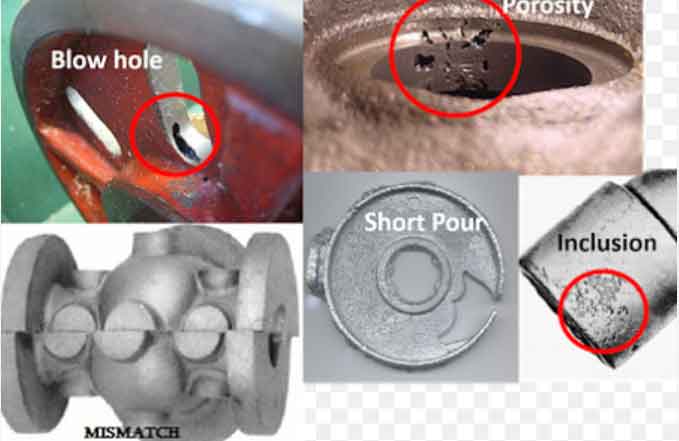
Detecting and resolving casting defects is a critical aspect of ensuring the production of high-quality castings. This comprehensive guide provides an overview of common casting defects, their causes, and effective resolution strategies. By following these guidelines, manufacturers can enhance their ability to identify and rectify casting defects, leading to improved casting quality and performance.
Common Casting Defects:
a) Porosity: Void spaces within the casting caused by gas entrapment during solidification, leading to reduced structural integrity.
b) Shrinkage: Volumetric contraction resulting in voids or cavities caused by inadequate feeding of the casting during solidification.
c) Inclusions: Foreign materials or impurities trapped within the casting, compromising its mechanical properties and performance.
d) Surface Defects: Irregularities on the casting surface, such as cracks, scabs, or roughness, affecting aesthetics and functionality.
e) Misruns and Cold Shuts: Incomplete filling of the mold cavity due to low fluidity or premature solidification, resulting in incomplete castings.
f) Warpage and Distortion: Deformation or bending of the casting caused by non-uniform cooling or stress during solidification.
Root Cause Analysis:
a) Process Variables: Analyze process parameters such as pouring temperature, cooling rate, mold design, and gating system to identify deviations from optimal conditions.
b) Material Considerations: Evaluate the casting material, including alloy composition, melt cleanliness, and fluidity, to determine their impact on defect formation.
c) Mold and Core Issues: Examine mold and core design, venting, and material properties to identify potential issues affecting solidification and the flow of molten metal.
d) Environmental Factors: Consider factors such as humidity, temperature, and atmospheric conditions that may affect the casting process.
Inspection and Detection Techniques:
a) Visual Inspection: Conduct thorough visual examinations to identify surface defects, dimensional variations, and irregularities in the casting.
b) Non-Destructive Testing (NDT): Utilize techniques such as X-ray, ultrasonic testing, magnetic particle inspection, and dye penetrant inspection to detect internal defects without damaging the casting.
c) Dimensional Measurement: Employ precise measurement tools, including coordinate measuring machines (CMM) or laser scanning, to verify dimensional accuracy and identify deviations.
Remediation Strategies:
a) Process Optimization: Adjust process parameters, such as pouring temperature, cooling rate, and mold design, to minimize defect formation and ensure proper solidification.
b) Gating and Riser Design: Optimize gating systems to promote proper metal flow, reduce turbulence, and ensure effective feeding. Use risers to provide additional molten metal for shrinkage compensation.
c) Alloy Modification: Adjust alloy composition or incorporate additives to improve fluidity, reduce shrinkage, or enhance mechanical properties.
d) Mold and Core Improvements: Enhance mold and core design, venting, and material properties to facilitate proper filling and solidification.
e) Heat Treatment and Post-Casting Operations: Apply appropriate heat treatment processes or secondary operations like stress relief, machining, or surface treatment to rectify defects or improve casting properties.
Continuous Improvement and Quality Control:
a) Data Analysis: Analyze historical defect data, process parameters, and quality metrics to identify trends, patterns, and areas for improvement.
b) Corrective Actions and CAPA: Implement systematic corrective and preventive actions to address identified defects and prevent their recurrence.
c) Training and Skill Development: Provide comprehensive training programs to enhance the skills and knowledge of casting personnel in defect recognition, process optimization, and quality control techniques.
d) Documentation and Lessons Learned: Document defect analysis, resolutions, and lessons learned to create a knowledge base for future reference and continuous improvement.
By employing effective defect detection techniques, conducting root cause analysis, and implementing appropriate remediation strategies, manufacturers can detect and resolve casting defects, leading to enhanced casting quality and performance. Continuous improvement, data-driven decision-making, and a strong focus on quality control are essential for minimizing defects and achieving defect-free castings. By following this comprehensive guide, manufacturers can ensure the production of high-quality castings and improve overall process efficiency.
